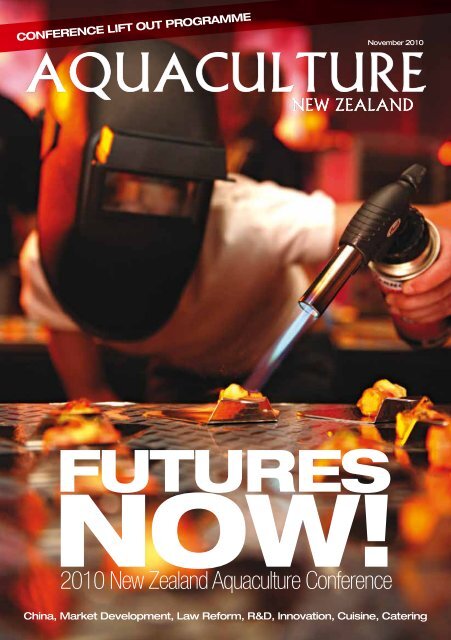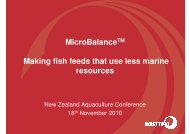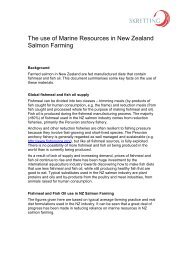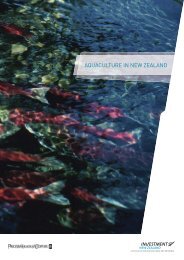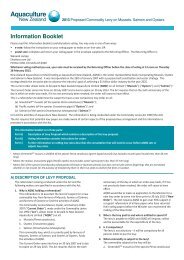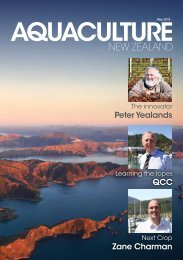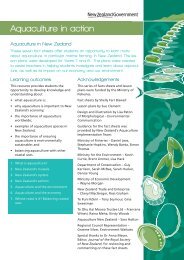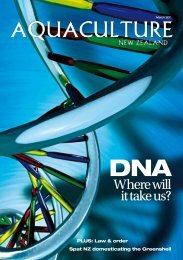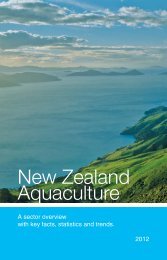November, 2010 - Aquaculture New Zealand
November, 2010 - Aquaculture New Zealand
November, 2010 - Aquaculture New Zealand
- No tags were found...
You also want an ePaper? Increase the reach of your titles
YUMPU automatically turns print PDFs into web optimized ePapers that Google loves.
As the owner/operator ofDenver’s Catering By Design,Cade Nagy can cater for upto 50 events per day. After15 years working from theground up, he has valuableinsights into the multi-billiondollar U.S. catering sector,from large-corporate caterers,to the military through toevent-style catering, . In amust-see presentation for allfood exporters, Cade will besharing his ideas on how to gaintraction in this lucrative marketat the <strong>2010</strong> <strong>New</strong> <strong>Zealand</strong><strong>Aquaculture</strong> Conference.TorchedTorched was all about theatrics and theflame. Chefs wearing welding masks,used butane torches to brulee items suchas <strong>New</strong> <strong>Zealand</strong> Greenshell mussels andoysters, served on custom pounded metalplates. While welding-outfit clad modelsperformed on stage behind the buffet.When It RainsI’m always reaching for new ways of featuringfood. And this one was indeed a reach.From an original concept drawn, like mostof my ideas, on a bar napkin, we made eightumbrellas out of steel bars. Each was 6 footacross and topped with a plexi glass top for thetable. I then had our receptionist sew the handpainted fabrics together to stretch over theumbrella frame. All it needed then were a fewjewels and some sparkle. And did I mention wealso made hand made pulled sugar raindropchandeliers to go over each umbrella?In his secondary role asdirector of the world’slargest catering trade show,CaterSource in Las Vegas, Cadeis renowned for throwing lavishparties that heavily influencethe industry’s trends. Ahead ofhis visit, we reveal some of...The Endless BuffetThis, 65 foot diameter, circular buffet, was builtto feed 2000 caterers quickly and efficientlywith little line. It was divided into 3 equalsections. Each section featured suspendedhand painted tree branches that anchoredtable-top buffet décor. Candles, custom lightfixtures, and menu signs, were suspended fromthe branches. Because of the round setup ofthe buffet, it seemed to never end, as therewas not a real starting or ending point. Livingcentrepieces stood on a stage in the centre ofthe buffet along with chefs.The TowersWe created the towers concept to giveus a new look and design for serving avariety of items for different applicationsand to be very flexible with how theywere used. Each set has four 8-foot talltowers constructed out of plywood andhardwoods then hand stained or painted.The towers can be used as a single pieceby connecting height adjustable shelvestogether, or as individual units.Cade’s CoolestCatering Conceptsthe salad BARWhen catering to caterers, I was looking for thenext thing we could all do in our markets. Witha little play on words, I decided to do “the saladBAR”. We took classic drink names, The Cosmo,The Margarita, and Saki and turned them intosalads. Printed the menu items on the blackt-shirts of the “Salad Tenders”. You walked up tothis all white BAR that actually portrayed a bar.Ordered off of the shirt, we then tossed the saladingredients together in martini shakers andpoured into the appropriate glass. Cheers!The Living ChandelierThis was a new way of breaking a toastfor guests. We used a 7-foot diametersteel ring as the base for holding bottlesof champagne suspended 12 feet in theair with a sexy sequined athlete hung bytheir ankles through the centre. To reachthe champagne, they needed to use theirstomach muscles to reach up and grab thebottles. While upside down, they would popthe cork, then guests would reach up to thegirl with a flute in hand to receive the pour.Dangerous? You bet. But how cool?4 N o v e m b e r 2 0 1 0 5
Conference programme lift outTalking toshellfish– how does thismake you feel?Talking to mussels won’t help youbreed better-quality products.But listening to them might.Cawthron shellfishphysiologist Norman Ragg hasdevised a number of innovativetechniques that allow him tocommunicate with mussels aspart of the Institute’s selectiveWORK & PLAY IN PARADISEHOT WATER BEACH 40 Orua Lanebreeding programme.His way of talking to shellfishinvolves electrodes and heartmonitors.As Dr Ragg will demonstrateat the <strong>New</strong> <strong>Zealand</strong> <strong>Aquaculture</strong>Conference, by measuring ananimal’s response to changesin temperate, stress and foodCome and discover this unique property with an opportunity to liveyour lifestyle dream. Approx 16.74ha with own access to surf/divebeach and a 3bdrm/2bath Intalok beach house plus hot water bore.Imagine after the days work is done being able to walk down to thebeach and unwind enjoying all your recreational needs with yourfamily and friends.The 1065 square metre shedhouses an aquaculture set-upincluding a 20 tonne (abalone)Global Oceans recirculationsystem (20x Aqua tanks, blowers,pumps, generator, grader,filters etc).Tender closes 4pm, 11th <strong>November</strong> <strong>2010</strong>, 41 Albert St, Whitiangawww.rwwhitianga.co.nz/WTI20123Katrina Carlyon Licensee Salesperson021 724 200 a/h: 07 867 1551katrina.carlyon@raywhite.comRay White Whitianga 07 866 2190AJ Innes Real Estate Ltd Licensed (REAA 2008)environment he can theoreticallyidentify animals with desirabletraits that could lead to productswith a longer shelf life, a highertolerance for processing or moreefficient growth.“If you can envisage a musselsitting in a psychiatrist chair weask them two types of questions,”Dr Ragg said.“The first is ‘how do youfeel?’ – a question asked of anunknown situation when it couldbe in pristine condition or understress – we monitor the feeding,metabolism and heart activity toget the answer.“Then the other question is‘how does this make you feel?’Which sounds the same but isfundamentally different becauseyou ask the question, then youapply the stress.“You know something aboutthe animal beforehand from thebaseline information then youchange the situation – very oftenit’s changing it for the worse.“The objective is to determinehow well the animal tolerates theless than optimal conditions.”If you were able to visualiseDr Ragg consulting with hismussel patient – now visualisethe mussel politely answering hisquestions from that comfortablepsychiatrist’s chair.“Yes they do talk back.They’re talking to us by means ofvarious physiological changes,”Dr Ragg said.“So if you ask ‘how doesthis make you feel?’ – it’s prettyhard to tell what’s going oninside a mussel, but if you’vegot access to informationlike its heart rate or oxygenconsumption, it’s instantaneousfeedback and that’s as effectiveas language.”And as he immerses himselfdeeper in the project, Dr Raggis finding great insight fromheart rates.“One of the key parameterswe’re finding really useful, thatgives us data and is really reliablebecause it works every time, is tomonitor heart activity.“I look at temperaturesensitivity.“If you have two shells thatcan close tightly, you can isolateand protect yourself from almostanything, except temperature.“So when on-growing andduring processing the creature’sability to survive temperaturestress is absolutely crucial. Youcan’t avoid it, you can’t getaround it.“Initial trials show geneticsplays a big part.“There are some lines that arejust more tolerant. Our aim is toefficiently identify and breed fora range of key characteristics,effectively providing growerswith access to designer musselssuited to a wide range ofconditions and requirements”Dr Ragg will be demonstratinghow to measure a musselheart rate at the <strong>New</strong> <strong>Zealand</strong><strong>Aquaculture</strong> Conference on<strong>November</strong> 18. •<strong>New</strong> <strong>Zealand</strong> <strong>Aquaculture</strong> Conference17-18 Nov <strong>2010</strong>. Rutherford Hotel, Nelsonin association with6 N o v e m b e r 2 0 1 0 7
N o v e m b e r 1 7 , 1 8 , 1 9 . N e l s o n<strong>New</strong> <strong>Zealand</strong> <strong>Aquaculture</strong> Conference <strong>2010</strong> TimetableSpeakersWednesday 17th <strong>November</strong> <strong>2010</strong>Time Session Location Time Session Location8:00 – 9:00am Registration & Crema Coffee Ground Floor3:10 – 3:50pm Afternoon Tea – Proudly sponsored by Aperio Level 2 FoyerRt Hon. John KeySunil KadriGillian WrattHon. Phil HeatleyWayne McNeeHamish Midgley9:00 – 9:10am Powhiri Reverend Harvey Ruru Maitai Room9:10 – 9:20am Welcome Peter Vitasovich Maitai RoomChairman <strong>Aquaculture</strong> <strong>New</strong> <strong>Zealand</strong>9:20 – 10:00am Plenary 1 Guest Speaker Maitai RoomOpening Key Note Address10:00 – 10:40am Plenary 2 Jason Shoebridge Maitai RoomTNS Conversa, CEOFutures NOW – Translating the trends10:40 – 11:20am Morning Tea Level 2 Foyer11:20 – 12:10pm Plenary 3 Panel Facilitated by Peter Vitasovich Maitai Room<strong>Aquaculture</strong> in <strong>New</strong> <strong>Zealand</strong>and Futures NOW12:10 – 1:10pm Lunch – Proudly sponsored by Rabobank Oceano Level 21:10 – 1:50pm Plenary 4 Sunil Kadri Maitai RoomDirector <strong>Aquaculture</strong>Innovation ScotlandCommercialising Innovation1:50 – 2:30pm Plenary 5 Hon. Phil Heatley Maitai RoomMinister of Fisheries and <strong>Aquaculture</strong>3:50 – 4:30pm Plenary 7 Gillian Wratt CEO Maitai RoomChris Cornelisen Marine ScientistCawthron InstituteMeeting Environmental Challenges of aGrowing <strong>Aquaculture</strong> Industry4:30 – 5:10pm Plenary 8 Cade Nagy – USA Catering Chef Maitai RoomInsights into Catering – Products, Price & Function6:30pmCoach Transfer – Rutherford Hotel to Cocktail Function7:00 – 10:00pm Cocktail Function World of Wearable Arts + Classic Cars MuseumThursday 18th <strong>November</strong> <strong>2010</strong>8:30 – 8:50am Registration Honghap Tang Ground FloorTraditional Korean ‘Pick Me Up’8:50 – 9:30am Plenary 9 Hamish Midgley Maitai RoomRabobank Business Banking Manager‘The Global Economic Outlook for2011 and Beyond’9:30 – 10:30am Plenary 10 Rt Hon. John Key Prime Minister Maitai Room10:30 – 11:10am Morning Tea Level 2 FoyerSpeakersCade Nagy Chris CornelisenNorman Ragg AJ Hu2:30 – 3:10pm Plenary 6 Wayne McNee Maitai RoomCEO Ministry of Fisheries<strong>Aquaculture</strong> Law ReformDan LeesDirector <strong>Aquaculture</strong> Unit Ministry of Fisheries<strong>Aquaculture</strong> Unit Update11:10 – 11:50am Breakout Sunil Kadri Maitai RoomSession 1 Future Economic ApplicationsBreakout Peter Ritchie Waimea RoomSession 2 Victoria University GenomicsBreakoutSession 3Maori in <strong>Aquaculture</strong>Dan LeesJason Shoebridge11:50 – 12:30pm Breakout Panel – Implementing the new Act Maitai RoomSession 4 Facilitated by Mike BurrellCEO <strong>Aquaculture</strong> <strong>New</strong> <strong>Zealand</strong>Breakout Richard Smullen Waimea RoomSession 5 Technical Manager& Nutritionalist - Ridley AquafeedThe future in <strong>Aquaculture</strong> NutritionBreakoutSession 6Maori in <strong>Aquaculture</strong>12:30 – 1:30pm Lunch – Proudly sponsored by Sanford Oceano – Level 2Kevin Heasman8N o v e m b e r 2 0 1 0 9
Time Session Location1:30 – 2:10pm Breakout Norman Ragg Maitai RoomSession 7 Shellfish Physiologist/<strong>Aquaculture</strong> ScientistCawthron InstituteHow to talk to shellfish&Kevin Heasman<strong>Aquaculture</strong> Scientist Cawthron InstituteA brief overview of open ocean shellfishfarming around the world todayBreakout Dr Rhys Hauler Waimea RoomSession 8 SkrettingMicrobalance, allowing fish feedsto make low use of marine resources2:10 – 2:50pm Breakout NIWA Maitai RoomSession 9Breakout Hamish Rennie Waimea RoomSession 10 Lincoln UniversityPlanning and Future Opportunitiesfor <strong>Aquaculture</strong> – Ways Forward2:50 – 3:20pm Afternoon Tea Level 2 Foyer3:20 – 4:00pm Plenary 11 AJ Hu Maitai RoomPartner, JLJ Group (Shanghai, China)Undertaking Business in ChinaCooking with aconscienceYou won’t find itprinted on their menu,but Logan Brown isa restaurant with aconscience.Thanks in no smallpart to executivechef, and <strong>New</strong><strong>Zealand</strong> <strong>Aquaculture</strong>Conference guestspeaker, ShaunClouston who iswell known in theWellington food scenefor his penchant for cooking withsustainable products.“We don’t promote the fact, but wehave a restaurant with a conscience,”Clouston said.Alongside free range eggs andline-caught snapper, you’ll find<strong>New</strong> <strong>Zealand</strong>’s king salmon inShaun’s fridges.“If you have line caught fish, orsomething that’s treated well by a farmerit shows through on the plate,” he said.“And our customers appreciate it.”It’s an attitude mirrored in Shaun’scooking style.“We have such great products, sowe use a really simple style of cooking,”he said.“We still put a lot of work into it, butit’s simply presented.“We like to have the great flavoursand the purity ofthe product speakfor itself.”It’s those flavoursand purity thatShaun served upto a discerningAustralian audiencerecently during atwo-week, pop-uprestaurant concept.Shaun wasone of four chefsapproached byWellington Tourism to travel with therestaurant to showcase the best of thecapital’s dining scene.As part of Shaun’s contribution, heput Citrus Cured Regal King SalmonGravalax on the menu.“I was really excited about takingthe dish to Sydney,” he said.“I was able to present a dish that Ihad never taken out of <strong>New</strong> <strong>Zealand</strong>before, using great <strong>New</strong> <strong>Zealand</strong>seafood and <strong>New</strong> <strong>Zealand</strong> products.”Shaun will be sharing the reactionand response <strong>New</strong> <strong>Zealand</strong>’s KingSalmon drew from the Australiandiners when he appears at the <strong>2010</strong><strong>New</strong> <strong>Zealand</strong> <strong>Aquaculture</strong> Conference.Sponsored by Regal King Salmon,Shaun will be preparing salmoncanapés for delegatesat the Cocktail Party. •Shaun CloustonMagic musselhangover cureForget hair of the dog, beard of the mussel is thehangover cure of choice in Korea.Actually it’s more of a mussel soup ratherthan just the beard, but Honghap Tang iswell known around the country’s drinkinghouses for its medicinal properties intreating self-inflicted pain.While traditionally made with the blackvariety, <strong>New</strong> <strong>Zealand</strong> Trade and EnterpriseSeoul team member Young-Gyun Shin saidGreenshell mussels were gaining popularity.“In Korea, the black shell mussel soupis served for free when drinking at manyrestaurants, particularly in Busan,” YG said.“There are some black shell musselspecialty restaurants and they serve variouskinds of mussel soups – these are not free.“It is prepared at home too as a hangoversoup. You have it while you’re drinking alcoholor the in the morning and you feel that thesoup soothes your stomach.“As mussels contain taurine which hasliver detoxifying properties, it is good for hangover.”In a variation to the traditional recipe, <strong>New</strong><strong>Zealand</strong>’s humble Greenshell variety is provingequally popular for those who indulged in onetoo many.“We tried to use <strong>New</strong> <strong>Zealand</strong> Greenshellmussels during the Seoul Food & Hotel Show andthis soup had a better and richer taste,” YG said.“Many visitors loved it.”So it goes well with soju, but will it work after anight on the Speights?“Yes, it is very easy to prepare and is very tastyand is very effective,” YG said. •recipe4:00 – 4:30pm Plenary 12 Shaun Clouston Maitai RoomExecutive Chef - Logan BrownCulinary insights from NZ’s best4:30 – 5:00pm Conference Peter Vitasovich Maitai RoomClosing Reverend Harvey RuruFriday 19th <strong>November</strong> <strong>2010</strong>Post Conference Field Day9:00 – 12noon Cawthron Hatchery Tour1:00 – 4:00pm Cawthron Hatchery TourShaun, (2nd from right) showing off <strong>New</strong> <strong>Zealand</strong>’s King Salmon at the pop-up restaurant in Sydney.Korean Greenshell Mussel SoupIngredients for two people• 100g Greenshell • 5g sliced green onionmussels, halfshell • 10g sliced garlic• 400ml water• Salt and black pepper• 8g sliced red pepperMethod1Boil water with Greenshell mussels and sliced garlic.Once boiled, turn the heat to low and boil for fivemore minutes.2Add sliced green onion and sliced red pepper andboil for three more minutes and add some saltand black pepper to taste. •10 N o v e m b e r 2 0 1 0 11
In late August DanLees was appointedDirector of the newlyformed <strong>Aquaculture</strong>Unit within the Ministryof Fisheries. Danhas worked for theMinistry of Fisheriessince 1999 and hasheld the positions of<strong>Aquaculture</strong> Managerand Central InshoreFisheries Manager.As <strong>Aquaculture</strong>Manager, Dan madeover 200 decisionson new aquaculturesites, worked onthe development ofinternational standardsfor wild catch fishingand aquaculture, andled a governmentgroup tasked withassisting the economicdevelopment of theaquaculture industry.To learn more about the<strong>Aquaculture</strong> Unit andhis new role, we got it...Direct Directorfrom theQ QYou led trekking groups through theWill the <strong>Aquaculture</strong> Unit haveHimalayas and Eastern Europe beforeany special powers?moving to <strong>New</strong> <strong>Zealand</strong> – do you see anysimilarities in climbing mountains to the challengeof leading the <strong>Aquaculture</strong> Unit?Leading groups in remote locationsDL is a challenge. People pay money totrek in the mountains and you need to meettheir expectations. Leading the <strong>Aquaculture</strong>Unit will also be a challenge, but one I amlooking forward to. The Government has highexpectations for aquaculture, the law reformsand the new Unit, and we must deliver resultsand value. The Minister of Fisheries and<strong>Aquaculture</strong> has made this very clear.QCan you briefly explain what isthe <strong>Aquaculture</strong> Unit and why hasit been created?The <strong>Aquaculture</strong> Unit is theDL Government’s principal advisor onmarine and land-based aquaculture. The Unitis within the Ministry of Fisheries becausethe Ministry is tasked with supportingaquaculture growth, a key part of theGovernment’s economic growth agenda.The Unit will ensure better coordination andprioritisation of the actions needed acrossgovernment agencies to help the aquacultureindustry grow.QIndustry and Government have expressedsimilar desires for growth. How do you thinkthe government/industry relationship should work?The relationship between the Unit,DL industry and other stakeholdersneeds to be candid and close. We need to beable to work together to identify opportunitiesfor the sector – both land-based and marine.Through the <strong>Aquaculture</strong> Unit we hope tostrengthen relationships with all stakeholders,including Maori, local communities, wildfisheries, researchers, environmental interests,and other user groups. It’s going to take all ofus to develop sustainable aquaculture.The Unit does not have any specialDL powers. The draft Bill, however, willcontain a provision that allows the Ministerresponsible for aquaculture to amend regionalcoastal plans through regulation. The new Unitwill provide advice to the Minister around useof this power, including whether consultationrequirements have been met. The Minister willnot approve individual resource consents –that will remain the job of the relevant council.QWhat are the priorities of the<strong>Aquaculture</strong> Unit?The <strong>Aquaculture</strong> Unit has threeDL priorities for the next year:• Lead implementation of the new law.• Complete the <strong>Aquaculture</strong> Strategy andAction Plan, and start delivering results.• Coordination between the groupsinvolved in aquaculture.Dan Lees – Director, <strong>Aquaculture</strong> UnitQHow will these improve orchange the industry?The proposed new law will reduceDL regulatory burdens for industryand increase certainty for all stakeholders– local communities, industry, Maori, andenvironmental interests. We need to makesure the new law is implemented properlyand understood by users to ensure thebenefits are realised.The Strategy and Action Plan will clearlyidentify how government will work withstakeholders to develop aquaculture. Thestrategy will cover projects to developnew space and species, and will also lookbroadly into research and innovation,market development, and iwi participation.The strategy will look across governmentportfolios at the actions needed to developsustainable aquaculture.Coordination and strong relationships willbe essential to success. Many governmentagencies’ work affects aquaculture and weneed to ensure we are all singing the samesong. We also need to work alongside AQNZ todevelop the necessary partnerships with localgovernment, iwi, and with other stakeholders.QRegulatory road blocks have been amajor hurdle for the industry over thepast decade, how do you plan to combat this?The proposed new law simplifiesDL the regulations governing marineaquaculture while a review of the land-basedaquaculture regime will begin in 2011.QWill the Unit have any effect over the dailyoperations on the water?Yes. In future we hope to see moreDL new farms, a widening diversity ofspecies grown around the coast, and morepeople employed in the sector.QWhat do you believe you need toachieve to be successful in this role?There are a number of things I willDL need to achieve:• Provide a clear direction for the<strong>Aquaculture</strong> Unit• Lead and ensure coordination acrossgovernment agencies• Work with industry and other stakeholdersto ensure the <strong>Aquaculture</strong> Strategy andAction Plan is achievable, practical andmakes commercial sense• Build and maintain the numerousrelationships needed to support aquaculture• Ensure Ministers are informed and advisedon aquaculture matters.QWhat will be yourmain challenge?There are challenges to us all inDL developing aquaculture in <strong>New</strong><strong>Zealand</strong>, and good things do not always comeeasily. One main challenge I have set for myselfand for the Unit is about building relationshipswith our stakeholders – from marine farmersto researchers to coastal planners. The successof a project is often based on the relationshipsyou build. The key is maintaining thoserelationships through the good and the bad.As a Unit, we will need to be able to returnanother day with another project.Another challenge is managingexpectations on what aquaculture candeliver. There are economic opportunitiesin aquaculture, but as people in the industryknow it is not easy money. Overall we needto make sure aquaculture development issustainable and encourage new entrants topresent a good business case. •12 N o v e m b e r 2 0 1 0 13
<strong>New</strong> <strong>Zealand</strong> <strong>Aquaculture</strong> Conference <strong>2010</strong>: SponsorsMaorimarine farmingLooking beyond its English translation,Kaitiakitanga could almost be interpretedas an investment strategy in the modernday context of the aquaculture industry.As explained by Toni Grant - an expert onMaori <strong>Aquaculture</strong> investment and Wakatu’sacting seafood sector CEO – for some iwifuture investment in the industry is not justabout the bottom line.“In a pure business sense, everyone’sfinancial goals should be the same – togrow and prosper,” she said.“But Maori also have other drivers –Kaitiakitanga, their guardianship role. Theyhave an affinity with the sea.“That’s how they arrived here andthey hold a responsibility to look after theresources, look after the land and look afterthe sea and the fish. <strong>Aquaculture</strong> is part offulfilling that role … growing somethingthat’s essentially organic.”“Kaitiakitanga is an inherentMaori value.”And it’s a value that might impact futureinvestment choices as the aquaculture lawreform looks likely to provide some iwi theopportunity to enter the industry for thefirst time.“In terms of the balance sheet –aquaculture is a high-risk investment fullstop,” she said.“But Maori are looking at the industryand thinking about it a lot more long term –as an intergenerational investment.“They see it as creating employmentopportunities for younger people comingthrough.“It also fits with another Maori philosophy– Ahika – which is about keeping the homefires burning and providing opportunitiesfor Maori to come back or to remain in theirregion, to live on historic lands and have realemployment opportunities.”But it’s too early to tell if this willprovide a comparative advantage in themarket place according to <strong>Aquaculture</strong><strong>New</strong> <strong>Zealand</strong> board member and long termmussel farm owner Harry Mikaere.“From a farming point of view,everybody’s in the same boat in terms ofvolume and value goals,” he said.“I think it is yet to be proved for Maoriwhether the cultural position of the group is aposition to be played out in the market place.“There still needs to be some work doneon that to gain a greater appreciation onwhether there’s extra benefit to come fromtheir understanding of the history of thosegrowing waters, the history of mussels, interms of Kaitiakitanga to Maori and thestories that go with those particular speciesand regional marine areas.”Market fundamentals remain the sameregardless of background.“Life on the water can be tough,”Harry said.“It’s a tough industry whether you’re onland or on the sea and it requires you to puta lot of time into this business.“Maori have got going in this industrywith a market driven approach, and if newMaori enterprises are to succeed, that sameapproach will be essential.”Experts agree that honourableintentions and an allocation of spaceare not enough to succeed in the highlycompetitive aquaculture sector.Te Ohu Kaimoana’s Laws Lawson says it’simperative that Maori who are consideringentering the industry are well versed on thePicture Scott Venning – www.scottvenning.co.nzfinancial realities of the business.“I think it is very important that we workwith iwi who have not yet been involved inaquaculture. Based on other publicity, theywho might be thinking that being allocatedspace as part of a settlement could mean thatthey will be able to walk into the bank, get aloan, and make good living day after day.“Life in aquaculture isn’t that way. Itrequires significant financing with capitalrequirements early as well as operationalexpenses and a lag before there can be anyoffsetting income. All this is in the contextof changing exchange rates. So it’s aninvestment that must be well understoodand carefully managed over time.“For those who have done their homework and know what they want to do thereare good opportunities if they can getfinance and carry through market cycles.“But for those who are starting atsquare one and don’t know much, butare offered an opportunity, it’s importantthey are well informed on the nature of allthings that could impact on what they’redoing, so they can plan appropriately toensure their success.” •Greenshell NZ Ltd.PlatinumGoldSilver14 N o v e m b e r 2 0 1 0 15


